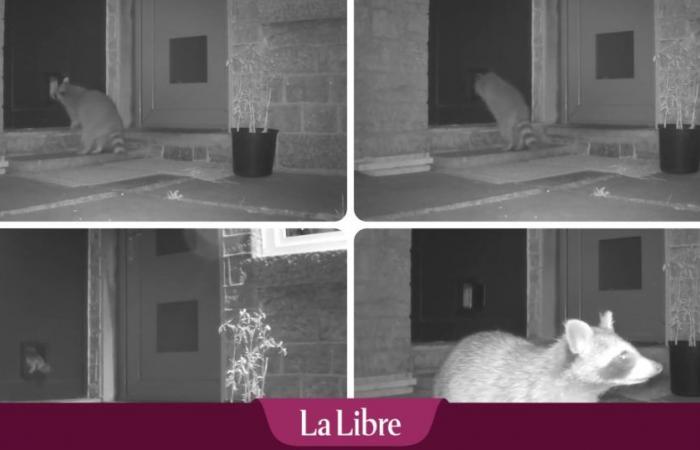Catherine, living in Vien (Anthisnes), still can’t believe it. While viewing her night camera, she discovered that a raccoon was entering her house at night through… the cat flap, although it had a chip. “Only our cat knows how to get in there, but the raccoon slips in easily, after having bypassed the flap, using its claws. It goes into the two laundry rooms to help itself to the cat’s kibble or the bird seed balls. It’s quite mind-blowing, I’ve never heard of that and I must say that it’s even a little worrying…”
From hedgehog to raccoon
For several weeks, Catherine had been aware that a raccoon was roaming the area… She had spotted it via her game camera placed in front of the hedgehog shelter recently set up at the back of the garden, to observe her new little protégé. “I had placed a bowl of food for him.” But on the camera images, it was no surprise to see the face of a raccoon coming to pilfer the seeds…”It’s a rat and she seems to have swollen breasts. We assume she has babies and must be feeding them. It was cute, we weren’t worried.” Days passed until this Monday, when the owner discovered remains of bird food in her house and in front of the door.An animal appeared to have snuck in, opened the lid of the plastic box housing the seed balls and nibbled on them, carrying some outside. There is only the cat flap as access. It seemed impossible to us. We therefore placed the night camera in front of the door and, the following night, we were able to discover the person responsible in images. The raccoon is extremely agile and fast…”
The animal therefore entered the house, took its little tour, had its fill before coming out just as easily. If, obviously, the lady has nothing against the animal (“I am an animal lover”), she is very upset today. She cannot condemn the cat flap. “I’ll have to look into how to tinker with something. But the problem needs to be fixed because the animal has settled in and will come back, and maybe even during the day, when we’re moving around the house. I don’t have any options at the moment.”
Not knowing what to do, the Anthisnoise contacted the Municipality, for advice, to find out if other cases had been recorded, while we are observing an upsurge of the animal in Wallonia, ever closer to homes. “Maybe they can do something, advise me, catch the animal in a cage to release it elsewhere…” She also launched a message via Facebook to raise awareness and launch a call for testimonies. “To date, no one in the neighborhood has seen any other raccoons…”
Public trash can visited
In the Commune, alderman Michel Evans says he has not been alerted recently by nuisances linked to raccoons. But he is well aware of the phenomenon, even in Anthisnes. “If, five years ago, we could observe some traces of its existence, today, we can see them regularly with the naked eye: in car headlights, in embankments, in gardens. And they are less and less shy. For example, we detected that a public trash can near a wood was regularly the target of a raccoon. But for individuals, unfortunately, we can do nothing.”
Etienne Branquart (SPW): “Remove all food outside”
So what can we do when we see a raccoon that is too intrusive? Etienne Branquart, an expert in invasive exotic species at the SPW (Public Service of Wallonia), is clear on the issue: remove all food near homes. Without food, it runs elsewhere. Without food, it reproduces less. With a few simple actions, we can avoid attracting them.Because they are super greedy and have a very developed sense of smell. You should know that a place rich in food first attracts a raccoon, but can quickly attract a dozen.”
What gestures? Make your trash cans inaccessible, even if it means placing a lock on it (raccoons are very agile), remove all pet food outside (at least at night because the animal is nocturnal), avoid throwing leftover food in a compost (or have a closed compost with a lid), secure your henhouse (the raccoon is a predator of chickens)…”All these steps must be applied to the entire neighborhood, of course, otherwise it will have no impact.” To raise awareness of the phenomenon, a campaign has been launched since May: “Stop invasive exotic species” with a section devoted to feeding. “We will also see with the municipalities how they can participate in this awareness raising”the expert continues.
And the cat flaps? Yes, they are a weak point in homes. They are regularly forced open by the raccoon.Yes, it’s common, confirms Etienne Branquart, even with high-tech devices. They are very clever. And there is no solution except to condemn the cat flap or block it from the inside for the night.”
The raccoon dog, an animal that belongs to the canine family but resembles a raccoon, can be infected with the coronavirus and, potentially, serve as an intermediary for contamination from bats to humans.
©AE/AFP/Archives
100,000 raccoons in Belgium
The expert confirms in any case a boom in the raccoon population in Belgium, which is difficult to stem.By extrapolation, the number of subjects is estimated at 100,000, but there are certainly many more.” We know that they have been present in Germany since 2006 and that they are gradually colonizing the eastern part of Belgium. They are mainly located in the provinces of Luxembourg, Liège and Namur. “We see that this invasion front is progressing towards Brussels and Flanders, explains the scientist, and, in places already colonized, we have noticed for a year an increase and a densification of the population.”
Not harmful, but invasive
The animal is not a pest, but is included on the European list of invasive alien species. And the nuisances are more and more numerous: raccoons disrupt biodiversity in certain areas, and can be dangerous for domestic animals (cats in particular) and even for humans. “You should definitely not try to tame them. They bite because they are fearful. And they are vectors of pathologies transmissible to humans.” So there is also a health risk.
To control the population, for the moment, the SPW and the DNF are relying on awareness-raising work and occasional trapping actions carried out by forestry agents. “But the DNF is not able to respond to all requests, specifically those from individuals.” For the citizen, there remains the solution of using a specialized company. “But that’s just shifting the problem.”
More broadly, the Region is considering a regional control plan to further stem the proliferation of the species.A study is underway to study different strategies for destroying the animal in certain sensitive areas, particularly where waterbirds are threatened by this predator. This is the case at Lake Virelles for example. concludes Etienne Branquart.






